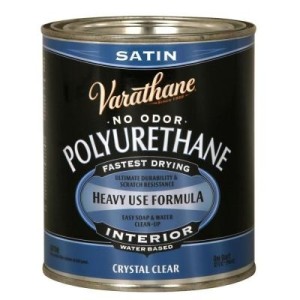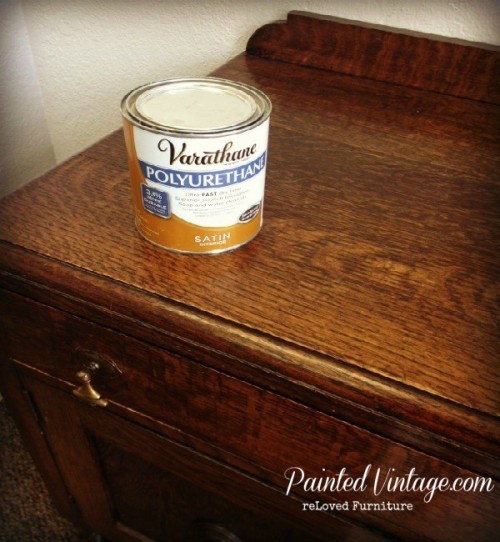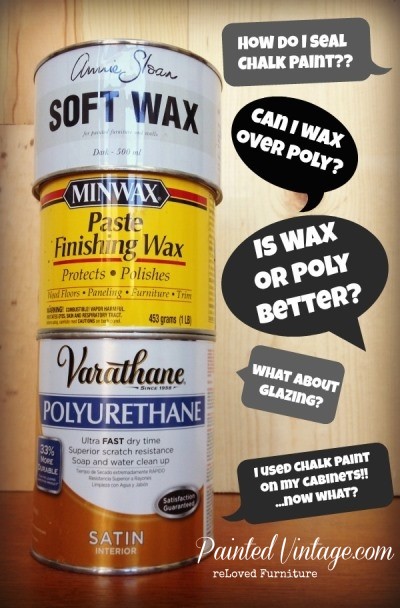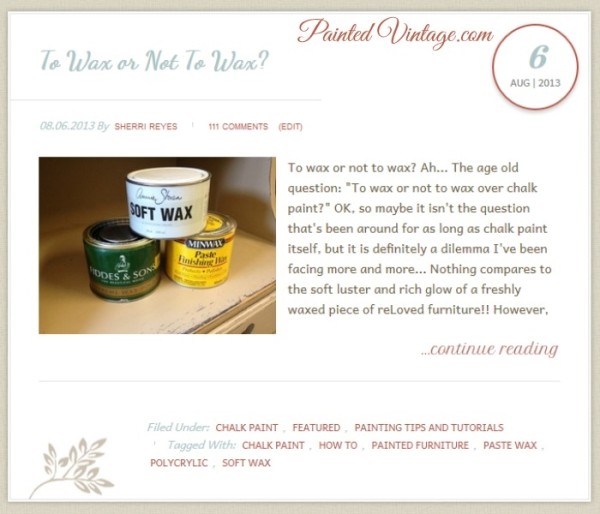Wax or Polycrylic over chalk paint?
All your questions about using wax vs. polycrylic over chalk paint answered!
The response has been overwhelming to my post on using wax or polycrylic over chalk paint (you can read the original post here: To Wax or Not to Wax?)
So, I decided to post an update with answers to your most frequently asked questions on applying a finish over chalk paint and wax alternatives.
Should I use a wax OR polycrylic over chalk paint? The answer really depends on how you will use the piece of furniture and how much time you are willing to invest in maintaining the finish. As I explained in my original post To Wax or Not to Wax? while waxing over chalk paint (or any variation of chalk style paint such as clay paint, mineral paint, and even DIY chalk paint) gives you a gorgeous velvety luster, it is NOT A PERMANENT finish and must be reapplied frequently to maintain the look and the protection of the wax. So if you absolutely must have the waxed finish, be prepared to also bust out a big can of elbow grease every few months!
That’s where water-based polyurethane finishes come in. Known as polycrylics, these finishes are an excellent alternative to use over chalk paint, for several reasons. Mostly they offer more of a permanent, durable finish that does not need to be reapplied. They are not heat sensitive like waxes are and they do not need to be completely removed should you chose to repaint. Oh, and they do not require any special courses in correct application techniques!
So for me personally, polycrylic wins the wax vs. poly challenge, hands down as my go-to finish of choice over chalk painted furniture.
What kind of wax would you use? Honestly, I rarely wax over chalk painted furniture anymore. But occasions do arise when I will use waxes. I love Minwax Paste Finishing Wax. It’s easy to work with and buffs out to a gorgeous finish! Another big plus is that it’s easy to find!! If I am going to be using a dark wax, I like the Annie Sloan Soft Wax.
What type of clear sealer do you use over chalk paint? There are several brands of water based polycrylics available. Admittedly, I have not tried them all, but I have tried several. I really like the Minwax Polycrylic, and I also love ease of the Minwax Wipe-On Poly for small projects. But, my all-time favorite is Varathane Crystal Clear Water-Based Polyurethane.
 Varathane Crystal Clear Poly goes on a little milky, but dries clear and stays clear! I have NEVER had any issues with Varathane Crystal Clear yellowing, as some polycrylics can over white painted furniture. This is my go-to product when applying a polyurethane over WHITE chalk paint. It is getting harder to find this product. But depending on which state you live in, you can still order online from HomeDepot.com
Varathane Crystal Clear Poly goes on a little milky, but dries clear and stays clear! I have NEVER had any issues with Varathane Crystal Clear yellowing, as some polycrylics can over white painted furniture. This is my go-to product when applying a polyurethane over WHITE chalk paint. It is getting harder to find this product. But depending on which state you live in, you can still order online from HomeDepot.com
In my area, the Crystal Clear formula has been replaced with a white labeled can that just reads: Varethane Polyurethane. I have been using this product for several months, and so far **knocking this wood buffet** I seem to have the same results as the Crystal Clear formula. UPDATE 9/15/14: I contacted Rustoleum and have been told the white label can is NOT the beloved Crystal Clear Formula. So , while I have not experienced any yellowing, I just want to clarify, THIS IS NOT IS CRYSTAL CLEAR FORMULA.

I should point out that POLYCRYLIC generally refers to a water-based finish, and POLYURETHANE refers to an oil-based finish. Varathane calls both their water-based and oil-based formulas by the generic “Polyurethane” name. In this post, I am specifically referring to the water-based formula only. Oil-based polyurethanes WILL AMBER over time.
How do you apply the poly over chalk paint? Using a good quality synthetic brush (Purdy’s are my preference) apply the poly in the direction of the natural wood grain. Using long, even strokes, work in one direction only, and try not to “over work” it by going back and forth into the wet area. Allow it to dry a couple hours between coats. While it does not require sanding between coats, I will sometimes sand lightly with a brown paper bag (yes, the grocery / lunch sack kind) if I need to knock down any bumps or little ridges. This can also be done after to buff it out to a gorgeous shine.
I have already waxed over my chalk paint, can I just apply poly over the wax? No. If you have used wax, it must be completely removed prior to applying anything. You cannot apply polycrylic over a waxed surface. You see, as the wax dries it becomes a natural water repellant. WAX REPELS WATER. That’s what wax does. Therefore, the poly has nothing to adhere to, because the wax is busy doing its job of repelling… An easy rule of thumb to remember IF your are going to use wax: “WAX IS LAST”
“Wax is Last”
Now, I have read that Annie Sloan wax can be top-coated with a polycrylic. Besides ASCP, I have also heard other chalk style paint manufactures claiming that you can apply poly over wax. I personally will never recommend that, and neither do the polycrylic manufactures. The back of my can reads “surface must be free from wax before applying” in two different areas of the label.
What about painting over wax? Same concept as above applies. If you would like to repaint furniture that has already been chalk painted and waxed, you must remove the wax first. Paint will not adhere directly to the wax. Wax can be removed by wiping the surface down with mineral spirits. Once the wax has been removed, you can proceed with your project. (Now I personally, would still prime with Zinsser Cover Stain, but I’m old school that way.)
Again, I have heard Annie Sloan Chalk Paint and a few other chalk-style manufactures say you can apply chalk paint, clay paint, or mineral paint directly over wax. I personally, would never suggest this. My preferred method for painting over wax, is to remove the wax FIRST. (…annnnd I’d probably prime)
Can I apply wax over polycrylic? Yes, you can. If you want the durability of the poly, but the look of a wax, you can use them together AS LONG AS THE WAX IS THE FINAL COAT. Because of the nature of wax and the way it cures, I would suggest using a matte poly if you want a wax top coat. Allow it to dry completely before waxing.
Can I apply Dark Wax over poly? Yes. Remember the rule “Wax is Last” So if dark wax is going to be your last step, you can absolutely apply it over poly. If you have just painted furniture with chalk paint and you want to really bring out the details and give your piece some character, dark wax is a wonderful product. Apply the poly first, so the dark wax does not stain the porous chalk paint.
Can I glaze over the poly? Yes, you can. If you want to add a dark glaze over chalk paint, apply a light coat of poly so the glaze does not stain the porous chalk paint. You can then glaze on top, once the poly is dried. You’ll want to apply another coat or two of the poly after you’ve waited patiently for the glaze to completely dry- don’t rush the waiting part here… it’s important. Otherwise you’ll make a mess- just trust me…
Can I use Chalk Paint over the polycrylic? Yes, you can. That is one of the benefits of using a polycrylic vs wax. If you change your mind on the color, or simply want to repaint your furniture piece later on down the road, you can do that! The poly does not need to be removed.
What kind of sealer do you recommend for Chalk Painted kitchen cabinets? A polycrylic would be my preference. I would not use a wax for a few reasons. If you’re like me, your cabinets will need to be wiped down almost daily. Splashes, spills and tons of chocolatey little fingerprints may need to be scrubbed. Lots of heat from all the cooking and baking that may (or may not) be going on… Wax will wear down very quickly under those conditions and will need to be re-applied more frequently. Let’s face it, waxing kitchen cabinets is not high on my monthly to-do list of chores. If I am going to spend the time to redo kitchen cabinets, I only want to do it once, and forget it! I really don’t need frequent reminders of what hard work that can be!
What kind of sealer can I use on my kitchen table top? For the same reasons listed above, I would use a polycrylic. At least 4-6 coats would provide a gorgeous, durable finish that would hold up well under the use and abuse a kitchen / dining table may receive. If I really wanted a virtually indestructible finish, I’d go with the Varathane Floor Finish.
Disclaimer: Although I think I would be a heck of a great spokesperson… (are you listening @rustoleum??) I am not sponsored or compensated in any way by Varathane. I just love the brand and have used it for dozens of years, even back when it was called Diamond by Flecto.
I hope you will find my answers to these frequently asked questions helpful in your research about using wax or polycrylic over chalk paint. These are actual questions I have been asked by my readers, and the answers given are what I would do in a given situation, based on my personal experiences. If you’d like to read my original post, you can find it here:








Do you still recommend wax over chalk paint for a heavily used kitchen table? -thanks so much!!! Love your blog!
I would probably use a water-based polyurethane.
My previous comment said “latex” enamel. It was just enamel.
Can I paint over polycrylic with latex enamel paint or do I have to resand it? Against my wishes, my husband painted the vanity and applied the polycrylic. I wanted to apply another coat or two of the paint before the polycrylic was applied because I don’t think he put it on thick enough.. I read someplace that you have to sand off the polycrylic. If there are no issues with using chalkpaint over the polycrylic I might just go that route because I am not going to sand off the polycrylic.
Of the Varathane crystal clear finishes- which would you use for kitchen cabinets? Satin? Semi gloss? Or gloss?
Thanks!
Hello I have a question??
In your questions, you state you could recommend using dark wax over poly for the aged look (since you can’t poly over wax). Would this be something that needs re-applied like a full wax finish would need? I am painting a dresser for a client that I need the aged look for, but I do not want her to have to re-apply the wax, so I was leaning towards the poly. However, still need the dark wax! Any other suggestions? Glaze? I haven’t worked with it.
I was considering using a dark walnut stain instead of the glaze or wax. (my paint color is dark gray) Is it better to use the stain over the paint, before the poly? Or use the stain over the poly? Thanks so much! BTW this is the BEST article EVER for these types of questions. I will refer to it over and over, as there are so many options, its hard to test them all out, Thanks so much for posting this and replying to others comments with helpful tips.
Very informative, thanks so much for taking the time to post this. My wife and I are going to try our hand at refinishing/flipping furniture and this was very helpful :O)
Is it possible to use “aging dust” before applying the poly?
Varathane Floor Finish yellow?
Can I use polycrylic over over a decoupaged table top (over three coats of mod podge)?
yes you can!
I have just painted a storage cabinet with chalk paint and waxed. I am not happy with the wax finish. If I use mineral spirits to remove the wax, will it ruin the chalk paint also?
Great timing, read your article before waxing and now plan of using varathane. One question, if I wanted the distressed look, I can still do that with sand paper after painting with chalk paint? Thank you!
Yes, you can!
Hi, great Article. I was wondering if you have experience with using staining, for distressing, on top of the poly coat? Thanks
Yes, you can use stain as a glaze over the poly. That will give the base coat some protection, so it doesn’t’ grab the stain. Also, you have a longer open time working with stain than traditional water-based glazes.
Which would you recommend using on upholstery after chalk painting it? It’s a piece that will be used everyday!
where do you buy Paint Minerals?
Terri, most folks I know that have used Paint Minerals are not happy with the result. They used to partner with a larger company and just pulled out due to unhappy customers. If you are looking for a cheaper alternative for your own furniture, not that you would sell, I will tell you to get a quart of Maison Blanche Furniture Paint, Amy Howard or Lowe’s has chalk paint now, but it is not high quality. You can also make your own, there are recipes all over FB.
Lisa, I think you must be confusing Paint Minerals with another product… Your comments regarding the partner company and unhappy customers is simply not true. Paint Minerals is an excellent product, and a far better alternative than making your own. I have nothing but positive remarks about the product, and have NEVER had a complaint!
Your comments are wholly untrue and rather unprofessional. I hope that bashing other artists is not how Mason Blanche does business.
Paint Minerals has never been partnered with any other company and has not been received poorly by anyone in any country it’s sold in. I am proud to say that it’s known for being an excellent product supported by excellent customer service. I take a lot of care in choosing highly-skilled artists and makers like Sherri who are qualified to represent it.
It’s not necessary to be limited to one kind of paint – there’s room in our toolboxes for all of the great products that are available whether we buy pre-mixed or make our own.
- Tref
Hi Teri- You can purchase Paint Minerals through my Etsy shop.
Here is a direct link.
I just started painting my cabinets and applied wax to the end caps and do not like the look of it. I found the crystal clear poly on Amazon but I’m wondering if satin is a good finish for cabinets or if it will be too dull. Do you recommend a semi or gloss? (I used Annie Sloan old white if that makes a difference)